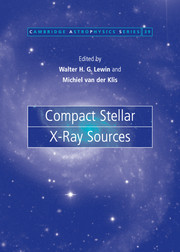Book contents
- Frontmatter
- Contents
- List of contributors
- Preface
- 1 Accreting neutron stars and black holes: a decade of discoveries
- 2 Rapid X-ray variability
- 3 New views of thermonuclear bursts
- 4 Black hole binaries
- 5 Optical, ultraviolet and infrared observations of X-ray binaries
- 6 Fast X-ray transients and X-ray flashes
- 7 Isolated neutron stars
- 8 Globular cluster X-ray sources
- 9 Jets from X-ray binaries
- 10 X-rays from cataclysmic variables
- 11 Super-soft sources
- 12 Compact steller X-ray sources in normal galaxies
- 13 Accretion in compact binaries
- 14 Soft gamma repeaters and anomalous X-ray pulsars: magnetar candidates
- 15 Cosmic gamma-ray bursts, their afterglows, and their host galaxies
- 16 Formation and evolution of compact stellar X-ray sources
- Author index
- Subject index
3 - New views of thermonuclear bursts
Published online by Cambridge University Press: 01 September 2009
- Frontmatter
- Contents
- List of contributors
- Preface
- 1 Accreting neutron stars and black holes: a decade of discoveries
- 2 Rapid X-ray variability
- 3 New views of thermonuclear bursts
- 4 Black hole binaries
- 5 Optical, ultraviolet and infrared observations of X-ray binaries
- 6 Fast X-ray transients and X-ray flashes
- 7 Isolated neutron stars
- 8 Globular cluster X-ray sources
- 9 Jets from X-ray binaries
- 10 X-rays from cataclysmic variables
- 11 Super-soft sources
- 12 Compact steller X-ray sources in normal galaxies
- 13 Accretion in compact binaries
- 14 Soft gamma repeaters and anomalous X-ray pulsars: magnetar candidates
- 15 Cosmic gamma-ray bursts, their afterglows, and their host galaxies
- 16 Formation and evolution of compact stellar X-ray sources
- Author index
- Subject index
Summary
Introduction
Many accreting neutron stars erupt in spectacular thermonuclear conflagrations every few hours to days. These events, known as Type I X-ray bursts, or simply X-ray bursts, are the subject of our review. Since the last review of X-ray burst phenomenology was written (Lewin, van Paradijs & Taam 1993; hereafter LVT), powerful new X-ray observatories, the Rossi X-ray Timing Explorer (RXTE), the Italian–Dutch BeppoSAX mission, XMM-Newton and Chandra have enabled the discovery of entirely new phenomena associated with thermonuclear burning on neutron stars. Some of these new findings include: (i) the discovery of millisecond (300–600 Hz) oscillations during bursts, so-called “burst oscillations”; (ii) a new regime of nuclear burning on neutron stars which manifests itself through the generation of hours-long flares about once a decade, now referred to as “superbursts”; (iii) discoveries of bursts from low accretion rate neutron stars; and (iv) new evidence for discrete spectral features from bursting neutron stars.
It is perhaps surprising that nuclear physics plays such a prominent role in the phenomenology of an accreting neutron star, as the gravitational energy released per accreted baryon (of mass mp), GMmp/R ≈ 200 MeV, is so much larger than the nuclear energy released by fusion (≈5 MeV when a solar mix goes to heavy elements). Indeed, if the accreted fuel was burned at the rate of accretion, any evidence of nuclear physics would be swamped by the light from released gravitational energy.
- Type
- Chapter
- Information
- Compact Stellar X-ray Sources , pp. 113 - 156Publisher: Cambridge University PressPrint publication year: 2006
- 212
- Cited by



